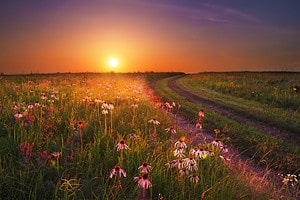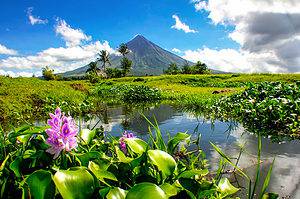Pennsylvania has a rich history, diverse culture, and scenic beauty. It’s also home to the mountain laurel, a native evergreen shrub that has been the state’s official flower since 1933. But how did this shrub become the official state flower of Pennsylvania? What makes it so special and unique among plants? Read on as we explore mountain laurel’s history, characteristics, and significance. We’ll also cover its blooming season and the best places to admire it.
What is Mountain Laurel?
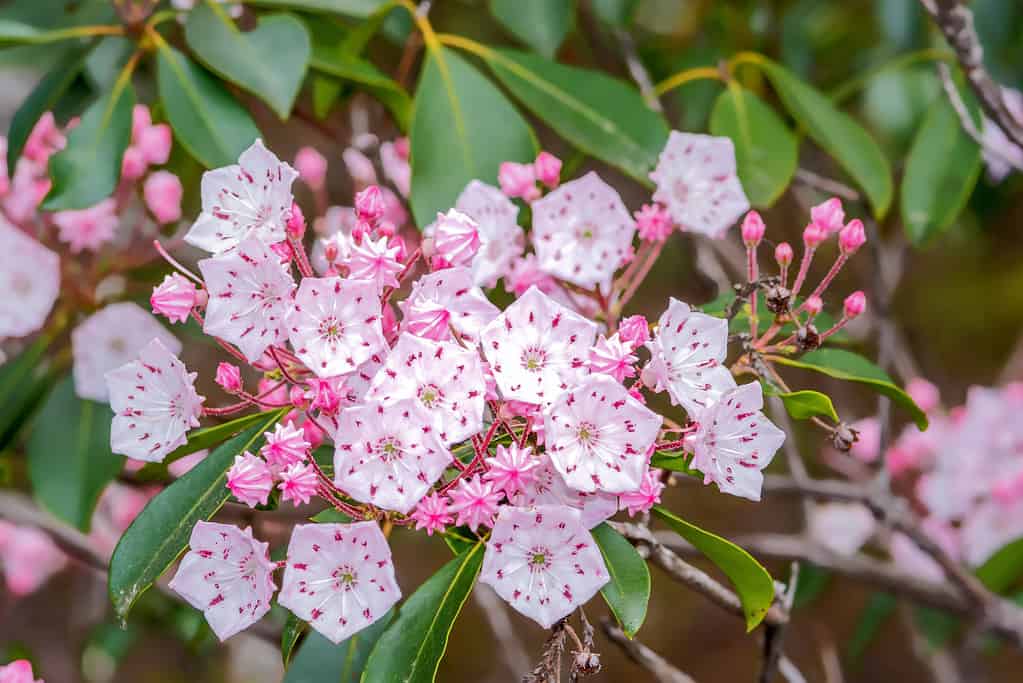
The outstanding characteristic of the mountain laurel is its star-shaped flowers that display a range of white and pink hues.
©JayL/Shutterstock.com
Mountain laurel (Kalmia latifolia) is a flowering plant that belongs to the Heath family, along with other species like blueberries, cranberries, azaleas, and rhododendrons. The plant likes acidic soil with a pH of 5-5.5. It grows in forests, hillsides, and rocky slopes. Mountain laurels can grow to 5-10 feet in height, with dark green leaves measuring 1-5 inches in length and 1-4 centimeters (0.4-1.6 inches) in width.
The outstanding characteristic of the mountain laurel is its star-shaped flowers that display a range of white and pink hues. The blooms are clustered at the branch tips and contain 10 stamens.
The Pollination of Mountain Laurel
Mountain laurel’s flowers have a unique mechanism for pollination that involves catapulting pollen onto visiting insects. Here is how it works and why it matters:
The Catapults of Mountain Laurel
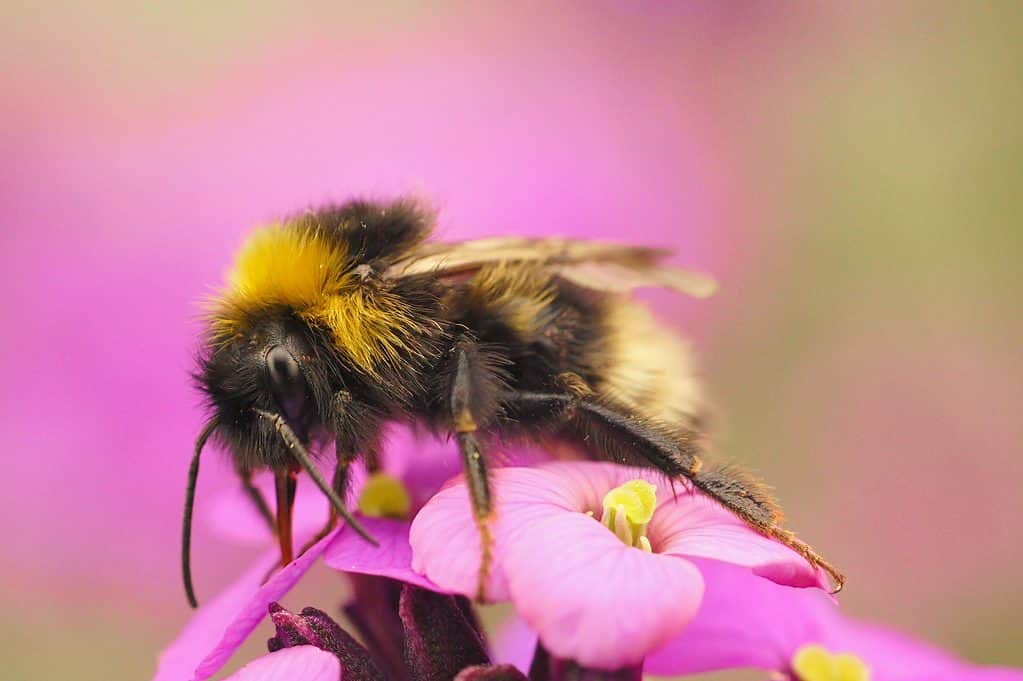
The primary pollinators of mountain laurels are bumblebees, which have hairy bodies that can catch and transport pollen efficiently.
©HWall/Shutterstock.com
The flowers have 10 arms or filament catapults that hold the male parts of the plant, called anthers. These are stuck in tiny pockets on each petal, creating tension in the filaments. When an insect lands on the flower and pulls at a filament, it triggers the release of the anther, which flings pollen into the air with great speed and force.
A study by Harvard researchers found that catapults can launch pollen at a speed of about 8 miles per hour, which is more than 400 times the acceleration due to gravity.
The primary pollinators of mountain laurels are bumblebees, which have hairy bodies that can catch and transport pollen efficiently. Other insects, such as hummingbirds and moths, may also visit mountain laurel flowers but may not trigger or receive as much pollen as bumblebees.
When Does Mountain Laurel Bloom?
The blooming season of mountain laurel occurs between late May and mid-June. The beautiful flowers emit a delightful scent and bloom for approximately two to three weeks.
Where to See Mountain Laurel in Pennsylvania
You have many options if you want to see mountain laurels in Pennsylvania. The plant grows abundantly in state parks, forests, game lands, scenic trails, and natural areas. Here are some of the best places to enjoy this floral wonder:
Bear Run Nature Reserve
One of the top destinations for mountain laurel lovers is Bear Run Nature Reserve, a 5,100-acre property owned by the Western Pennsylvania Conservancy. This reserve is located near Mill Run, Fayette County, and is home to Fallingwater, the famous house designed by Frank Lloyd Wright.
Bear Run Nature Reserve has over 20 miles of trails that wind through diverse habitats, including mature hemlock forests and wetlands. Along these trails, you can admire hundreds of mountain laurel plants that create a spectacular show when they bloom.
Enjoy other attractions at Bear Run Nature Reserve, such as birdwatching, fishing, and camping. The reserve is open year-round from dawn to dusk.
Skyline Drive
If you prefer driving to hiking, you can still enjoy mountain laurel views along Skyline Drive, a scenic road that runs along the spine of Chestnut Ridge just east of Uniontown.
The road is flanked on either side by mountain laurels, which can also be seen growing on rocky outcrops and cliffs. Additionally, multiple stops for picnicking and scenic viewing are available along the way. Skyline Drive is best accessible from April until November.
Mount Davis
Another great place to see mountain laurels is Mount Davis, Somerset County, the highest point in Pennsylvania at 3,213 feet above sea level. Mount Davis is part of Forbes State Forest and has several trails that lead to its summit.
While ascending, one can observe mountain laurel flora sprouting amid other shrubs from the Heath family, like rhododendrons, azaleas, huckleberries, and blueberries.
At the top, you can climb a metal tower with a 360-degree view of the surrounding landscape, including more mountain laurel patches. Mount Davis is open year-round from sunrise to sunset.
Wolf Rocks
Wolf Rocks Trail is a 4.5-mile loop trail that starts at Laurel Summit State Park and passes through dense stands of mountain laurel before reaching Wolf Rocks.
Here, you can soak up the magnificent views of the valley beneath you, amidst an array of flourishing flowers. Wolf Rocks Trail is open year-round from sunrise to sunset.
Quebec Run Wild Area
Suppose you’re looking for a more secluded and wild experience. In that case, you might want to visit Quebec Run Wild Area, a 7,441-acre tract within Forbes State Forest that preserves some of the most pristine forests in Western Pennsylvania.
Quebec Run Wild Area has over 20 miles of trails that traverse rugged terrain and diverse ecosystems, including forests. Two trails that are especially good for seeing mountain laurels are Hess Trail and Tebolt Trail.
You can also camp at designated Quebec Run Wild Area sites to extend your stay. Quebec Run Wild Area is open year-round from sunrise to sunset.
Ricketts Glen State Park
Ricketts Glen State Park is one of the most scenic areas in Pennsylvania, with 13,193 acres of land. The park is home to the Glens Natural Area, a National Natural Landmark with 22 named waterfalls. But there’s more to see than just waterfalls at Ricketts Glen. In June, a visit to the park may offer the chance to catch sight of Pennsylvania’s official flower, the mountain laurel.
Pine Creek Gorge
Pine Creek Gorge, recognized as the Pennsylvania equivalent of the Grand Canyon, is an awe-inspiring natural marvel that draws numerous tourists annually. The gorge is carved by Pine Creek and spans 47 miles through the Allegheny Plateau. It offers scenic views, hiking trails, wildlife, and historical sites.
The best time to visit Pine Creek Gorge to see mountain laurels is from late May to early July when they are in full bloom. However, you can also enjoy the beauty of Pine Creek Gorge year-round, as it offers different attractions for each season.
During the fall, you can appreciate the vivid foliage. As winter descends, it transforms into a magical snowy wonderland. In spring and summer, the trails come alive with the sounds of nature, and plenty of activities can keep you entertained.
Laurel Hill State Park
Laurel Hill State Park is a scenic area of 3,935 acres in Somerset County, Pennsylvania. The park provides various recreational activities such as hiking trails, camping spots, fishing spots, and an artificial lake spanning 63 acres for swimming and boating. However, an alluring aspect of the park is the profusion of the mountain laurel.
Delaware Water Gap National Recreation Area
Delaware Water Gap National Recreation Area encompasses 70,000 acres of land along 40 miles of the Delaware River. With over 150 miles of hiking trails, some of which are part of the famous Appalachian Trail, the park provides stunning vistas of the river, blooming flowers, cascading waterfalls, verdant forests, and diverse wildlife.
Additionally, visitors can engage in recreational activities such as fishing, boating, swimming, and camping. The gap also marks the border between New Jersey and Pennsylvania.
How Did Mountain Laurel Become Pennsylvania’s State Flower?
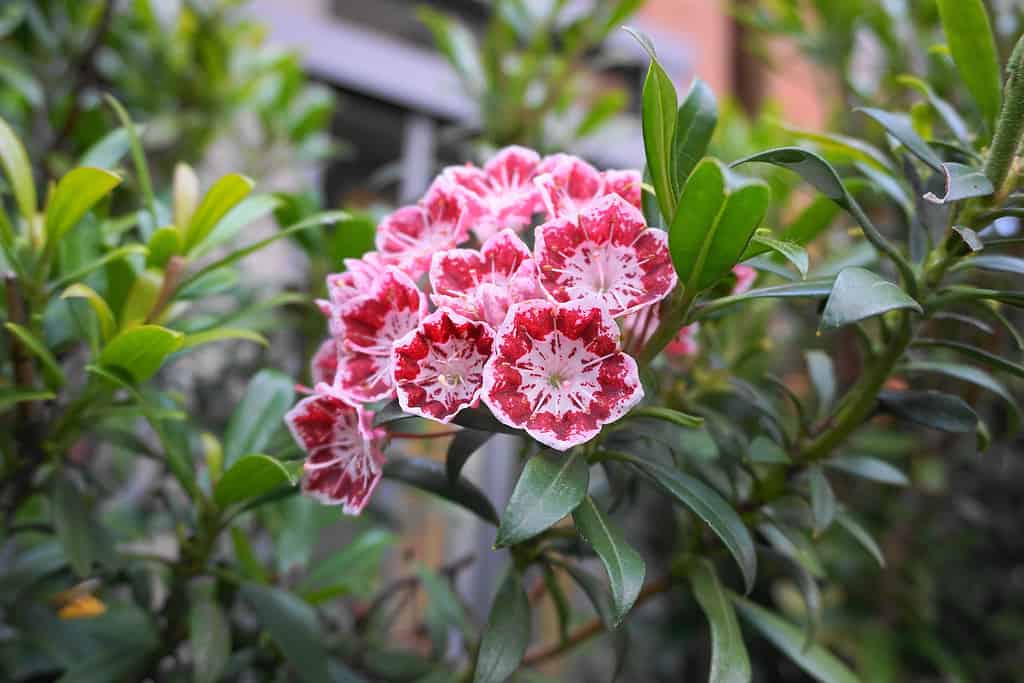
It was first recorded in America by European explorers in 1624 and was named after Peter Kalm, a Finnish botanist who studied it.
© lenic/Shutterstock.com
Mountain laurel has a long and rich history in Pennsylvania and beyond. It’s native to the Eastern United States, from Maine to Florida and west to Indiana and Louisiana. It was first recorded in America by European explorers in 1624 and was named after Peter Kalm, a Finnish botanist who studied it during his travels in North America in the 18th century.
Native American Uses of Mountain Laurel
Native Americans used mountain laurel for various purposes, such as making spoons from its wood (hence one of its common names, “spoonwood”) and treating skin diseases with its leaves. Early colonists also enjoyed cultivating it as a decorative shrub to add charm and appeal to their gardens.
Designation of Mountain Laurel as Pennsylvania’s State Flower
In 1933, Pennsylvania Governor Gifford Pinchot had to choose between two bills that proposed either mountain laurel or pink azalea as the official state flower. His choice to select the mountain laurel as the official state flower wasn’t a hasty decision made in a vacuum. It resulted from careful deliberation, informed by various factors that ultimately led to this natural beauty’s coronation. These included:
- The plant’s wide distribution throughout the state
- Its historical association with Penn’s Woods (the original name of Pennsylvania)
- Its similarity in appearance to the rhododendron (the state flower of neighboring West Virginia)
- Its popularity among both residents and tourists
Furthermore, according to some sources, Governor Pinchot’s wife also influenced his decision by expressing her preference for mountain laurel over pink azalea.
He signed the bill into law on May 5th, making mountain laurel Pennsylvania’s state flower. Since then, the mountain laurel has brought immense pride to the people of Pennsylvania and stands as an emblem of their ecological legacy. Mountain laurel has also been the state flower of Connecticut since 1907.
Is Mountain Laurel Poisonous?
Mountain laurel contains grayanotoxin and arbutin, which can cause nausea, vomiting, diarrhea, drowsiness, convulsions, blurred vision, and even paralysis if ingested. The poison is most potent in the young leaves and shoots, but all parts of the plant are toxic. Even honey made from mountain laurel nectar can be harmful.
The symptoms of mountain laurel poisoning can vary depending on the amount and type of exposure. DoItYourself reports that children who suck on the flowers may experience stomach pain and a runny nose. At the same time, animals that eat too much of the leaves and stems may suffer from staggering, drooling, and breathing difficulties.
Mountain laurel can also be fatal to horses, goats, cattle, deer, and monkeys. Even dead leaves can retain their toxicity for a long time.
How to Avoid Mountain Laurel Poisoning
The best way to prevent mountain laurel poisoning is to avoid contact with the plant altogether. If you have mountain laurel in your garden or near your home, ensure it’s fenced off or clearly labeled as poisonous. Don’t let children or pets play near or eat any part of the plant. Don’t use mountain laurels for decoration or crafts.
If you encounter a mountain laurel in the wild, you should admire it from a safe distance and avoid picking any flowers or leaves. You should also be careful about buying honey from local sources that may have been contaminated by mountain laurel nectar.
If you suspect someone has been exposed to mountain laurel poison, you should seek medical attention immediately. Symptoms may not appear right away but can worsen over time. There is no specific antidote for mountain laurel poisoning, but supportive care may help reduce its effects.
Can Mountain Laurels Grow In Containers?
This shrub can grow in containers, but you need to follow some tips to ensure success:
Choosing the Right Container
You want a large container to accommodate your plant’s root system and provide adequate drainage. Generally speaking, a container at least 18 inches deep and 24 inches wide is recommended for growing mountain laurel. Plastic, ceramic, and metal containers are all good options for growing mountain laurels. However, avoid terracotta pots as they dry out quickly and crack in cold weather.
Choosing the Right Soil
Mountain laurels prefer acidic soil with good drainage and aeration. You can use a commercial potting mix designed for acid-loving plants or make your own by mixing equal loam and sand with organic matter such as peat moss or compost. You can add some perlite or vermiculite to improve drainage and prevent compaction. Before planting your mountain laurel, fill the container with soil and water it well until it drains completely. Then plant your shrub and gently water it.
Caring For Your Container-Grown Mountain Laurel
Mountain laurels need regular watering, especially during hot and dry periods. Check the soil moisture by inserting your finger into it. If it feels dry an inch below the surface, water your plant until water runs out of the drainage holes. Avoid overwatering or letting your plant sit in soggy soil because this can cause root rot or fungal diseases.
Mountain laurels also need some fertilization, but not too much. Apply a balanced fertilizer formulated for acid-loving plants once or twice a year, preferably in spring or early summer. Follow the label instructions carefully.
Prune your mountain laurel after flowering in late spring or early summer. Use sharp and clean pruning tools and make clean cuts just above a leaf node or branch junction. To prevent frost damage, move your container indoors or into a sheltered location when temperatures drop below freezing.
Final Thoughts on the Official State Flower of Pennsylvania
Pennsylvania has designated the mountain laurel as its official state flower. This evergreen shrub produces fragrant flowers in shades of pink and white with a star-like appearance, making them attractive to bees and other pollinators. The mountain laurel blooms from May to June and can be commonly found in the countryside of Pennsylvania.
The mountain laurel symbolizes Pennsylvania’s natural beauty and conservation efforts but is also toxic to humans and animals if ingested. Therefore, visitors should admire the flower from a safe distance and avoid touching or eating any part of it.
The photo featured at the top of this post is © lenic/Shutterstock.com
Thank you for reading! Have some feedback for us? Contact the AZ Animals editorial team.




